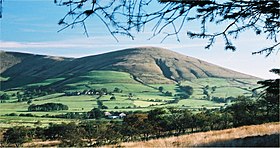
Back Forest of Bowland CEB Forest of Bowland German Forest of Bowland French Forest of Bowland Polish Forest of Bowland Swedish
| Forest of Bowland | |
|---|---|
 Ward's Stone is the highest point in the Forest of Bowland at 1,841 feet (561 m). | |
 The Forest of Bowland AONB shown (in green) with the district boundaries of Lancashire | |
| Location | England |
| Established | 1964 |

The Forest of Bowland, also known as the Bowland Fells and formerly the Chase of Bowland,[1] is an area of gritstone fells, deep valleys and peat moorland, mostly in north-east Lancashire, England, with a small part in North Yorkshire (however roughly half of the area falls into the area of the historic West Riding of Yorkshire). It is a western outlier of the Pennines.[2]
The Forest of Bowland was designated an Area of Outstanding Natural Beauty (AONB) in 1964. The AONB also includes a detached part known as the Forest of Pendle separated from the main part by the Ribble Valley, and anciently a royal forest with its own separate history. One of the best-known features of the area is Pendle Hill, which lies in Pendle Forest. There are more than 500 listed buildings and 18 scheduled monuments within the AONB.
The Trough of Bowland is a pass connecting the valley of the Marshaw Wyre with that of Langden Brook, and dividing the upland core of Bowland into two main blocks.
The hills on the western side of the Forest of Bowland attract walkers from Lancaster and the surrounding area. Overlooking Lancaster is Clougha Pike, the westernmost hill. The hills form a large horseshoe shape with its open end facing west. Clockwise from Lancaster the hills are Clougha Pike (413 m or 1,355 ft), Grit Fell (468 m or 1,535 ft), Ward's Stone (561 m or 1,841 ft), Wolfhole Crag (527 m or 1,729 ft), White Hill (544 m or 1,785 ft), Whins Brow (476 m or 1,562 ft), Totridge (496 m or 1,627 ft), Parlick (432 m or 1,417 ft), Fair Snape Fell (510 m or 1,670 ft), Bleasdale Moor (429 m or 1,407 ft), and Hawthornthwaite Fell (478 m or 1,568 ft).
The area contains, by one definition, the geographic centre of Great Britain which is close to the Whitendale Hanging Stones, around four miles (6 km) north of Dunsop Bridge.[3] The historical extent of Bowland Forest is divided into two large administrative townships, Great Bowland (Bowland Forest High and Bowland Forest Low) and Little Bowland (Bowland-with-Leagram), but the modern-day AONB covers a much larger area.
- ^ Porter, John (1974). A Forest in Transition: Bowland 1500–1650 (PDF). Vol. 125. The Historic Society of Lancashire & Cheshire. p. 40. Retrieved 12 January 2022.
- ^ Great Britain. Alan G. Ogilvie. 2 January 2014. ISBN 9781107626539. Retrieved 9 November 2017.
- ^ "Where Is The Centre Of Great Britain? | Blog". www.ordnancesurvey.co.uk. 22 August 2014. Retrieved 8 September 2021.